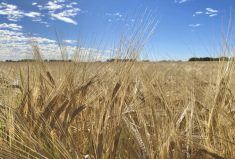Winter barley produces a higher-yielding, lower-moisture grain than spring-seeded barley. It’s appealing as a forage crop, as a cover crop and as a means of diversifying rotations. But in most of Canada, there’s just one problem — winter.
In Europe, winter malting barley is favoured over spring barley for its longer growing season and ability to capitalize on winter moisture. It’s double-cropped with soybeans across the southeastern United States. In Canada, it’s been grown in Ontario, Quebec and southern Alberta. Uptake is limited so far, but it has had perennial appeal for a niche group of growers.
Read Also

Agronomists share tips for evaluating new crop products and tech: Pt. 3
With new products, new production practices and new technology converging on the agriculture industry at a frenetic pace in recent…
“If I had a good winter barley it’d be very popular in southern Alberta,” says Greg Stamp of Stamp Seeds in Enchant, Alta. He says breeders have experimented with winter barley in the region for decades, but there’s always been a risk of winterkill. “Winter survival is just not predictable enough.”
Stamp Seeds carried a European KWS variety called Higgins, but discontinued it last year because of winterkill concerns. However, Stamp says the company is currently running a demonstration plot of a promising new two-row European variety. It will continue trials if it does well this winter. Any variety that performs well would be brought to market under the SeedNet banner.
In Ontario, winter barley has been around for a long time, says Phil Bailey, eastern business manager for SeCan.
“From a seed perspective, predicting the market is a problem. Demand is big one year and then you have a bad year with winterkill and then people stop wanting to grow it for a couple of years.”
It’s not winterkill, but springkill
SeCan is in the second year of registration trials for two new winter barley varieties that were bred with germplasm sourced from around the world for its improved winter survivability, and in their Canadian tests, Bailey says they’re performing well so far.
“It’s actually not the winter that kills it — it’s the spring when the crops wake up and freeze-thaw patterns really smoke winter barley. But we’ve had some tough freeze-thaw cycles the last couple springs, and this stuff came through, so we’re kind of excited about that.”

Bailey says SeCan is testing a malting variety as well as a feed barley, which potentially opens up another new market for growers. The varieties have been planted in four sites across the province in partnership with Quebec companies Semican and Sollio Ag. Yield data so far is promising, with mean yields of eight tonnes per hectare (144 bushels per acre) in some locations.
If all goes well seed should be available for fall 2021 planting. Bailey thinks the company could eventually be looking at 100,000 acres planted to winter barley in Ontario. He says SeCan isn’t doing anything with winter barley in Western Canada currently, but it’s open to doing trials in southern Alberta if the new varieties perform well in Ontario.
Agronomic tips
Kevin Smith, a professor in the University of Minnesota’s department of agronomy and plant genetics, has been running a winter barley breeding program for a decade, aiming to establish reliable winter barley varieties in the Midwest.
Smith’s collaborator is University of Minnesota plant pathologist Brian Steffenson, who screens germplasm and accessions from around the world and looks at winter barley’s wild relatives to find disease resistance and winter hardiness traits.
The university’s website reports results of a study from 2009 to 2018 with three winter barley varieties at five sites in Minnesota — two in the northern half of the state and three in the southern half. Survival was much higher at the three southern sites.
It says that when more than 50 per cent of the initial stand survived the winter, the varieties in the trial developed a sufficiently adequate canopy to suppress weeds and warranted to be harvested for grain. One variety, McGregor, met the 50 per cent winter survival threshold in more than half of all of the site-years in the southern to central region of Minnesota.
Smith says the university has an advanced six-row breeding line that it is considering for release. It is also developing malting barley varieties from germplasm from the Vavilov Institute collection in Russia. The team is also analyzing the factors that play into winter survivability.
“We co-ordinate a large national winter barley trial in over 30 locations in the U.S. We’re trying to collect climate data to see if we can identify climate parameters that predict survival.”
So far, Smith believes winterkill often happens when the temperature drops before there’s enough snow cover to insulate the crop.
Seeding date important
Agronomy, especially seeding date, also plays a large role in winter barley’s survivability. In seeding rate studies, Smith found that seeding too early could increase the risk of insect pest or powdery mildew damage to seedlings.
“We target October 1 for seeding in Minnesota. You want to plant late enough that there aren’t many insects around but you want a couple of leaves going into the winter.”
Bailey says SeCan aims to focus on grower education to maximize producers’ success with winter barley. He says his rule of thumb is to plant two weeks earlier than winter wheat. Producers should choose well-drained, sloping fields.
For southern Alberta, Stamp says seeding is ideally in early September. He believes seed treatment is also key to winter barley survival. He also recommends even seed placement at 3/4 inches deep so every plant is at a similar stage, and says higher seeding rates may offset winterkill risk.
















